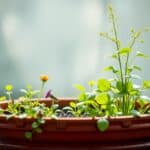Are Venus Fly Traps Succulents? Discover the Truth About These Unique Plants

Venus Fly Traps are fascinating plants known for their unique ability to capture and digest insects. Often admired for their distinctive appearance and intriguing behavior, many plant enthusiasts question whether these carnivorous wonders fall under the category of succulents. This article delves into the characteristics of Venus Fly Traps, exploring their native habitat, growth conditions, and biological traits. By examining the differences between succulents and these intriguing plants, we aim to provide clarity on their classification and care requirements. Join us as we uncover the truth about Venus Fly Traps and their place in the plant kingdom.
Are Venus Fly Traps Succulents?
The Venus flytrap (Dionaea muscipula) is often confused for a succulent, but it is not classified as one. Unlike succulents, which are characterized by their thick, fleshy tissues that store water, Venus flytraps are a type of carnivorous plant that predominantly thrives in nutrient-poor, acidic soils. They capture and digest insects to obtain essential nutrients, particularly nitrogen, which is scarce in their natural habitats. While some aspects of their growth may resemble succulents, mainly due to their compact size and care needs, their unique feeding mechanism and environmental adaptations set them apart.
What Defines a Succulent?
Succulents are plants that have adapted to store water in their tissues, making them highly resilient in arid conditions. They typically feature thick, fleshy leaves or stems that can retain moisture, allowing them to thrive in environments with limited water availability. Common examples of succulents include aloe, cactus, and echeveria. These plants come in various shapes and sizes but share the common trait of having the ability to endure drought by utilizing their water reserves.
How Do Venus Flytraps Capture Prey?
The Venus flytrap captures its prey using specialized leaves that function as traps. Each trap consists of two hinged lobes lined with sensory hairs. When an insect touches these hairs, it triggers a rapid closure of the lobes, ensnaring the prey. The plant then secretes digestive enzymes to break down the insect, allowing it to absorb vital nutrients. This mechanism is vital for the plant's survival, especially since it often grows in nutrient-poor soils where traditional nutrient uptake from the ground is insufficient.
Growing Conditions for Venus Flytraps
Venus flytraps thrive in conditions that mimic their native habitat, which includes high humidity, bright light, and wet, acidic soil. They prefer a mixture of sphagnum moss and perlite or silica sand to ensure proper drainage while retaining moisture. These plants also require distilled water or rainwater, as tap water often contains minerals that can harm them. Ideal temperatures for growth range from 70°F to 95°F (21°C to 35°C) during the day and drop at night, creating a favorable environment for their development.
See also:
Can Venus Flytraps Survive with Minimal Water?
While Venus flytraps do require a consistently moist environment, they are sensitive to water levels. Unlike succulents that can thrive on minimal water due to their storage capabilities, Venus flytraps must never be allowed to dry out completely as it can lead to stress or death. However, over watering can also be detrimental, making it crucial for caretakers to strike a balance and ensure that these plants are kept in continually damp conditions without waterlogging.
Are Venus Flytraps Hard to Care For?
Caring for Venus flytraps can be challenging for beginners, especially due to their unique requirements. They need an environment that provides high light levels, ample moisture, and specific soil types, which differ significantly from typical houseplants. Additionally, regular feeding, preferably with live insects, is essential for their health and growth. However, with the right conditions and a little practice, many enthusiasts find joy in growing these fascinating plants, which can reward them with intriguing carnivorous behavior and vibrant greenery.
| Characteristic | Venus Flytrap | Succulent |
|---|---|---|
| Water Storage | No | Yes |
| Soil Type | Acidic and nutrient-poor | Well-draining |
| Feeding Method | Carnivorous | Photosynthesis |
| Care Requirements | High humidity, distilled water | Varies by species |
| Growth Environment | Wet, bright | Diverse |
Understanding the Unique Characteristics of Venus Fly Traps
Venus Fly Traps, known scientifically as Dionaea muscipula, are not considered succulents, although they share some common environmental needs such as bright light and well-draining soil. These carnivorous plants thrive in nutrient-poor wetlands, relying on insects for their nutrient intake rather than relying solely on soil. Unlike succulents, which store water in their leaves, Venus Fly Traps have specialized structures to capture and digest their prey, making them fascinating but distinctively different from typical succulent varieties.
What Defines Succulents?
Succulents are characterized by their ability to store moisture in their leaves, stems, or roots, allowing them to thrive in arid conditions. This unique adaptation enables them to survive periods of drought by utilizing their internal water reserves. Succulents belong to various plant families and come in diverse shapes and sizes, with the most well-known types including Aloe, Echeveria, and Sedum.
Are Venus Fly Traps Carnivorous Plants?
Yes, Venus Fly Traps are categorized as carnivorous plants. They have evolved to attract and trap insects, which serve as a source of nutrients not readily available in their natural habitats. The plant uses its modified leaves, which snap shut when prey triggers sensitive hairs inside, aiding in the capture of insects, and subsequently digesting them to absorb essential nutrients such as nitrogen and phosphorus.
See also:
Similarities Between Venus Fly Traps and Succulents
While Venus Fly Traps are not succulents, they share some environmental preferences with them. Both types of plants often thrive in bright, indirect light and prefer well-draining soil to prevent waterlogging. Additionally, they exhibit resilience towards challenging conditions, making them favorites among indoor plant enthusiasts. However, their differing methods of nutrient acquisition highlight the fundamental distinctions between the two plant categories.
Growing Conditions for Venus Fly Traps
To successfully cultivate Venus Fly Traps, it's essential to replicate their native conditions as closely as possible. They prefer a humid environment with plenty of bright sunlight, thriving in acidic, nutrient-poor soil that closely resembles their natural habitat in the wetlands of the Southeastern United States. Regular watering with distilled or rainwater is also crucial, as these plants are sensitive to chemicals commonly found in tap water.
Common Myths About Venus Fly Traps
A common misconception is that Venus Fly Traps require frequent feeding to survive. In reality, they can thrive on sunlight and moisture for extended periods without actual insects. Additionally, many people believe that these plants are dangerous or aggressive; however, their traps only snap shut when an insect brushes against the sensitive hairs, and they pose no threat to humans or pets.
Questions from Our Readers
Are Venus fly traps considered succulents?
Venus fly traps are not considered succulents. While both types of plants are unique, succulents store water in their leaves and stems, whereas Venus fly traps are a type of carnivorous plant that captures and digests insects for nutrients.
What are the care requirements for Venus fly traps?
To thrive, Venus fly traps need high humidity, plenty of sunlight, and a specific type of soil that retains moisture but drains well. It is essential to keep them in a bog-like environment, often requiring distilled water to avoid any harm from chemicals.
See also:
Can Venus fly traps survive in low light conditions?
Venus fly traps struggle to thrive in low light conditions as they require a lot of direct sunlight to perform photosynthesis effectively. They typically need at least 12 hours of bright light each day to remain healthy and catch prey.
How often should Venus fly traps be fed?
Venus fly traps do not need frequent feeding and should be fed insects only when their traps are fully closed. Typically, feeding them every few weeks is sufficient, as they can get enough nutrients from sunlight and the soil as well.

If you want to read more articles like Are Venus Fly Traps Succulents? Discover the Truth About These Unique Plants, we recommend you check out our Planter category.
Leave a Reply
Related Articles